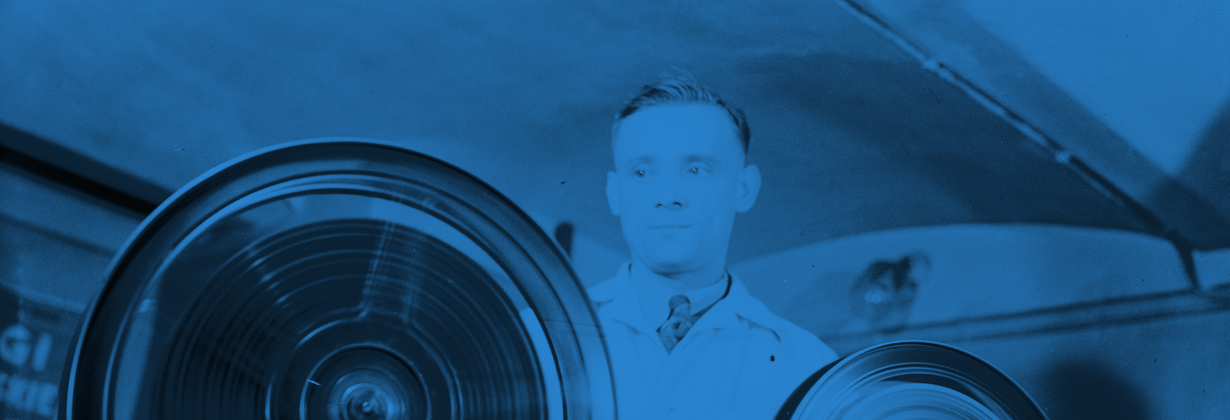Photographs
According to archiving rules, the photographs in the NDA are divided into groups and collections, most important ones including:
- Photographic Archive of the Illustrated Daily Courier containing nearly 190,000 photographs dated 1910 – 1939. The period of the 2nd Republic is documented most extensively: state authorities, political, social, religious life, economy, culture, science, education, military, sports, life of the Polish community abroad. It contains many photographs of foreign photographic agencies which cooperated with the IDC. It also contains photographs from the 1st World War with most of them showing Polish Legions.
- Press Publishers Kraków – Warsaw (Zeitungsverlag Krakau – Warschau) contains ca. 18,000 photographs dated 1939 – 1945. These are mostly propaganda pictures made for the prposes of the Third Reich showing German soldiers on the fronts of the 2nd World War, dignitaries and life in the occupied Polish lands, especially the General Guovernement.
- Private collections of that time contain photographs documenting combat trails and Polish soldiers in action during the 2nd World War. These are photographs made and collected by, among others, Czesław Datka, Tadeusz Szumański, Bolesław Denasiewicz, Tadeusz Jankowski, Władysław Choma, Władysław Gryksztas and Stefan Bałuk.
- Photographs of war destruction and the re-building of Warsaw were taken by Wacław Żdżarski and Stefan Rassalski.
Large, state-owned photographic agencies were operating during the Polish Peoples’ Republic period. The largest one, Central Photographic Agency (CAF), contains ca. 12 million photographs dated 1944 – 1990, and nearly 30 linear meters of file documents dated 1965-1990 (cutting lists). CAF’s photographs extensively document the Polish Peoples’ Republic period.
The second largest group in the NDA, Military Photographic Agency (WAF), includes ca. 2 million military photographs dated 1944 – 1996.
The post-war culture, art and architecture are presented on the photographs collected in private photographic archives of Władysław Miernicki, Stanisław Brzozowski and Edward Hartwig (the largest one) – containing more than 120,000 photographs dated 1945-1982 and documenting, among others, theatre plays. Photographic archives of Stanisław Wdowiński, Eugenia Trzeciakowa, Zbyszek Siemaszka present the contemporary and historical architecture of Poland.
With more than 100,000 photographs, an enormous documentation of the life of the Polish community in the United Kingdom in the years 1946-2008 was made by Juliusz Englert. The photographs show the political, social, cultural and religious activity of Polish organisations.
During the years 2014-2015, the NDA’s collections were expanded with legacies of the people of culture not directly involved into photographic or audiovisual work: actress Elżbieta Czyżewska and poet, writer, translator and Gypsy culture expert Jerzy Ficowski.
Recordings
The collection may be divided into two groups:
- Polish Section of the Radio Free Europe – nearly 17,000 recordings registered during the years 1952 – 1994.
- Recordings of various origins – ca. 5% cover the period up to 1939, 10% originate from the times of the 2nd World War, the remaining 85% originate from the Polish Peoples’ Republic period.
The most valuable are the recordings of voices of eminent Poles: Marshall Józef Piłsudski, Józef Beck, Władysław Anders, Ignacy Jan Paderewski or Stefan Żeromski.
Of interest are also the sound recordings of historical events, such as the annexation of Zaolzie to Poland, attack of German soldiers on Westerplatte, Father Jerzy Popiełuszko’s Masses for the Homeland. The collection also contains the programmes of the Polish Radio, accounts of cultural, sport, and state events. Melomans will find song recordings from the interwar period.
An interesting thing is that, in addition to typical sound materials, the NDA’s collections also contain scripts, i.e. full records of programmes of the Polish Radio and Polish Section of the Radio Free Europe.
The oldest recording in Polish in the NDA’s collection is probably dated 1908 and contains Christmas carols performed by an unknown church choir.
Films
a. 90% of the materials originate from the Institute of Educational Studies, „Sportfilm“ and „Czołόwka“ Film Studios, and Polish Interpress Agency. The majority of the collection contains film chronicles: Polish chronicles dated 1958 – 1975 (mostly army-related) and German chronicles from the 2nd World War period, focused on military activities on various fronts and life in the occupied territories, including the General Gouvernement.
Films about sports and educational films make up a large part of the collection.
Priceless are the films made in the 1920s and 1930s, including ‘Polonia Restituta’ documenting the efforts in negotiating the borders of the 2nd Republic of Poland.
The NDA are the owner of the archives of the Polish radio and Polish Television. The collections of the former “Polish Radio and Television” State Organisational Unit are also the property of the NDA. The collections contain archive materials produced in the Polish Radio and Television by the end of 1993, i.e.:
- nearly 135,000 films and TV programmes recorded on photosensitive and magnetic tapes of various formats dated 1958 – 1993;
- 665,000 recordings with verbal and music programmes broadcasted on four channels of the Polish Radio during the years 1950 – 1993 (earlier recordings were forwarded to the NDA).
On the basis of a lending for use agreement, the materials are housed by the Documentation and Programme Collections Centre of the Polish Television and the Archives of the Polish Radio.




